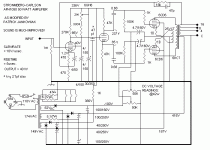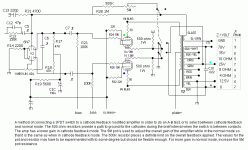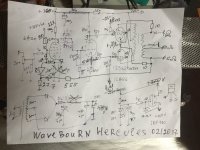I see a 2m2 resistor going to the splitter grid from the N Fdbk line. Another "local" N Fdbk?
No, just a DC voltage divider, to make both tubes happy on different voltages. The upper resistor is shunted by a cap. It supposed to be drawn to the ground.
Ever try an RC there to reduce the global N Fdbk at HF? I see the Dynaco ST70 had a small cap there.
No need to. It is already unconditionally stable.
Yes. LED biasing of input pentode (IR LED), frame grid video pentode-triode, MOSFET voltage regulator with Zener string for screen grids (can use VR150 though instead of Zeners), and local cathode feedback from 0-4 Ohm and 4-16 Ohm secondaries.
Mmmm... I am partial to an 0D3, despite the fact that they are far noisier than a typical zener, especially a zener with a soft knee. As pretty (and interesting) as it is, plasma is anything but quiet...
How do you measure your "Quiet"? What is amplification factor of 12BQ6 driven from G2, how that "anything but quiet" would be translated into output voltage, especially when feedbacks are applied to the amp? Nothing is absolutely quiet. We deal with S/N ratio that matters. And if a voltage regulator tube adds some noise on the level 1/100 of already existing noise floor, is it quiet enough, or not?
You can find noise voltage in datasheets for gas discharge tubes. And what is a "Zener with soft knee"?
You can find noise voltage in datasheets for gas discharge tubes. And what is a "Zener with soft knee"?
As said before, the EL84/6BQ5 tube may excel in a HiFi amp as well as in a MI amp. It solely depends on the amplifier design. Generally, a EL 34 isn't a good sub for a KT66 - too different paramenetrs, hence a possible degradation in sound if plugged into the same apparatus.No, different tubes have different characteristics. Personally much prefer Octal tubes like 6V6, KT66 etc for HFI. Tubes like EL84, 6BM8 were mostly used in cheap HIFI amps and there is a reason for it, cheaper to make. If you put side by side EL84 and 6V6 HIFI amp and listen, you'll hear the huge difference in sound production.
Some people say that all tubes can be made sound the same depending on circuit design, if that was the case than there would be only few power tubes to choose from. Why would people pay 100's of Dollars for vintage KT66 for their amp project if they just could use new EL34 and tweak the circuit to the right sound.
I'm quite convinced the gnd connection of your OT's secondary must read 4 ohms instead of 8.Try this one.
Best regards!
That ARRL 6BQ6 amplifier has no N Fdbk. The 4000 Ohm primary would translate the 20000 Ohm Ri of the 6BQ6 into 40 Ohms output Z, so no damping factor. 6V6 or any of it's updates, like 6EZ5, 6JC5 or 6MF8, at 50000 Ohm Ri are out for sure.
For no N Fdbk, we need a low Ri tube. 38/12HE7 is on the $1 list, with 6200 Ohm Ri. (38HE7 lets you power up just the beam pent.) Otherwise it will take one of the bigger TV Sweeps to get low Ri. The 6HJ5, with 5000 Ohm Ri, are sold out due to popularity. 6CB5, 5000 Ohm Ri, almost gone too. 6DQ5 is close to a 6HJ5, 5500 Ohm Ri. 42KN6 can get you 4000 Ohm Ri.
Otherwise, use some N Fdbk or go to triode mode.
For no N Fdbk, we need a low Ri tube. 38/12HE7 is on the $1 list, with 6200 Ohm Ri. (38HE7 lets you power up just the beam pent.) Otherwise it will take one of the bigger TV Sweeps to get low Ri. The 6HJ5, with 5000 Ohm Ri, are sold out due to popularity. 6CB5, 5000 Ohm Ri, almost gone too. 6DQ5 is close to a 6HJ5, 5500 Ohm Ri. 42KN6 can get you 4000 Ohm Ri.
Otherwise, use some N Fdbk or go to triode mode.
Last edited:
Oh, and 25/6DN6 gets you 4000 Ohm Ri, 15 Watt, for cheap, and in-efficient (high htr pwr), octal even.
This tube will even work at low B+ which is interesting. There are often requests on the forum for LV tubes, I don't think this one gets mentioned too often. George (Tubelab) has been experimenting with them lately.
Well, there is 26A7 for 2400 Ri, with just 2 Watts. Not very linear however.
Some other unknowns: 25EC6, 25HX5, 50JY6 all around 5000 Ohm Ri.
This tube will even work at low B+ which is interesting. There are often requests on the forum for LV tubes, I don't think this one gets mentioned too often. George (Tubelab) has been experimenting with them lately.
Well, there is 26A7 for 2400 Ri, with just 2 Watts. Not very linear however.
Some other unknowns: 25EC6, 25HX5, 50JY6 all around 5000 Ohm Ri.
Last edited:
On the 6BM8, and on NFB applied to output cathodes from the OPT secondary.
The 6BM8 was popular with designers of inexpensive sets. The triode + pentode arrangement, when used in push pull, saved the cost of a dual triode and a socket. The 6BM8 was registered with JETEC in 1956, sponsor Rogers Radio Tubes, Ltd later Rogers Electronics (Canada), Rogers Majestic Electronics. (6BM8 JETEC.pdf)
It is a well-developed (1956) dual purpose tube designed for audio and pulse, so it's not a surprise that it might have a little more distortion than a purpose-built audio tube. (ECL82-philips.pdf)
Lots of tubes mentioned, lots of choice. NFB needs used with all of them..
The 6BQ6 amp circuit shown above, using NFB to the cathodes from the OPT secondary can counteract much distortion if enough grid voltage swing is available to overcome the degenration.
(6BQ6 amp NCFB.jpg)
I was selling these modded APH1050's for a while in the 1980s, using the same NFB cathode circuit with H deflection tubes and everyone who bought them loved them. I had to increase the plate voltage on the driver to overcome the added, opposing K-GND voltage. (aph1050x.gif)
There's a way to connect a switch to do a/b comparisons with/without the neg CFB. There's always contention about it. (cath_feed_ab_test.gif)
My opinion/point is the best thing is going to be what pleases the builder/listener anyway!
The 6BM8 was popular with designers of inexpensive sets. The triode + pentode arrangement, when used in push pull, saved the cost of a dual triode and a socket. The 6BM8 was registered with JETEC in 1956, sponsor Rogers Radio Tubes, Ltd later Rogers Electronics (Canada), Rogers Majestic Electronics. (6BM8 JETEC.pdf)
It is a well-developed (1956) dual purpose tube designed for audio and pulse, so it's not a surprise that it might have a little more distortion than a purpose-built audio tube. (ECL82-philips.pdf)
Lots of tubes mentioned, lots of choice. NFB needs used with all of them..
The 6BQ6 amp circuit shown above, using NFB to the cathodes from the OPT secondary can counteract much distortion if enough grid voltage swing is available to overcome the degenration.
(6BQ6 amp NCFB.jpg)
I was selling these modded APH1050's for a while in the 1980s, using the same NFB cathode circuit with H deflection tubes and everyone who bought them loved them. I had to increase the plate voltage on the driver to overcome the added, opposing K-GND voltage. (aph1050x.gif)
There's a way to connect a switch to do a/b comparisons with/without the neg CFB. There's always contention about it. (cath_feed_ab_test.gif)
My opinion/point is the best thing is going to be what pleases the builder/listener anyway!
Attachments
Last edited:
I'm quite convinced the gnd connection of your OT's secondary must read 4 ohms instead of 8.
Best regards!
Yes, I screwed that letters, because outputs were marked before I added feedback. In short, "0 Ohm" is still marked as "0 Ohm", as well as 4 Ohm, 8 Ohm and 16 Ohm, but grounded is 4 Ohm tap, that is right in the middle between "0" and "16".
- Status
- This old topic is closed. If you want to reopen this topic, contact a moderator using the "Report Post" button.
- Home
- Amplifiers
- Tubes / Valves
- 5.6k Output transformer for 8k 6V6?


